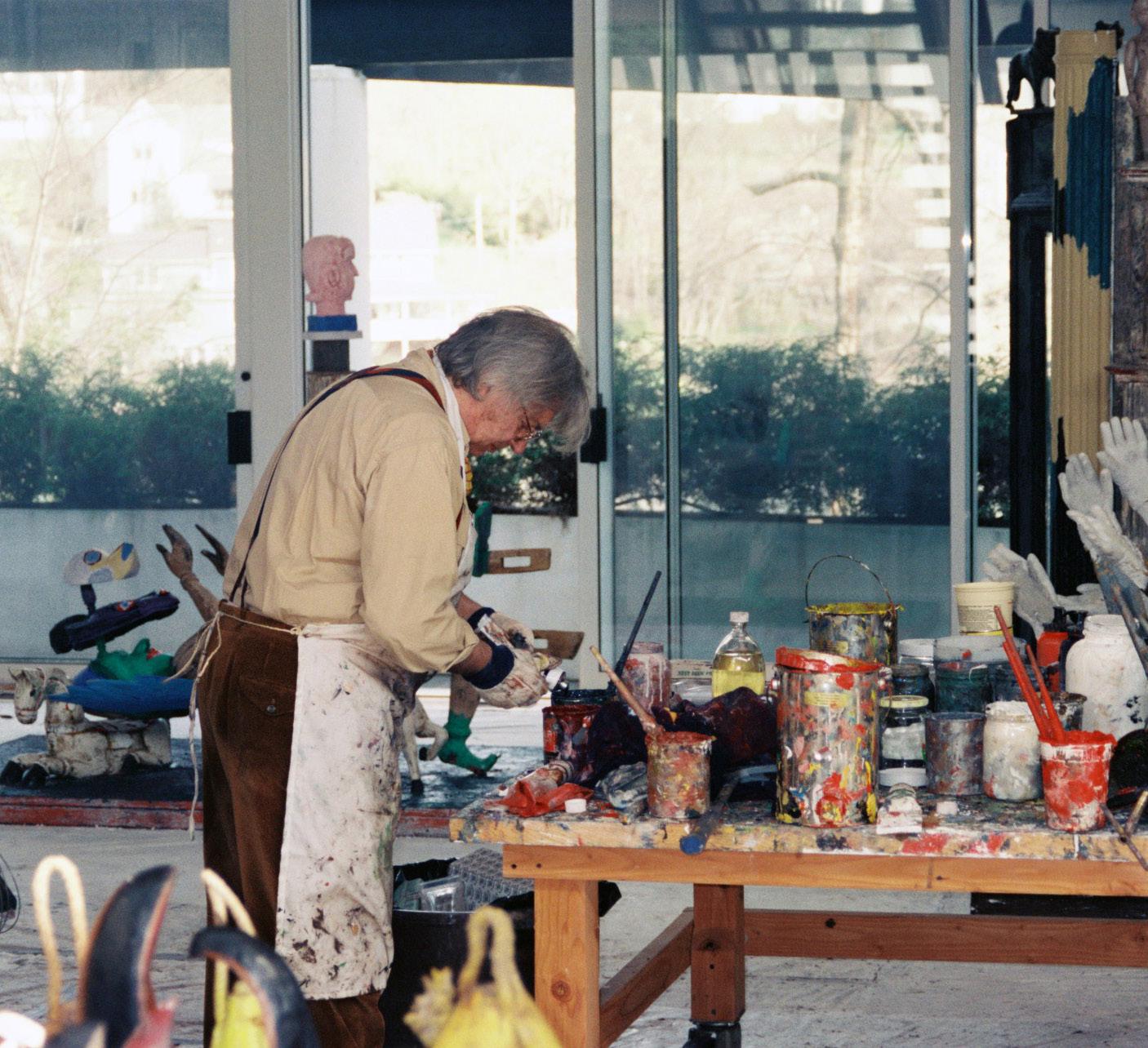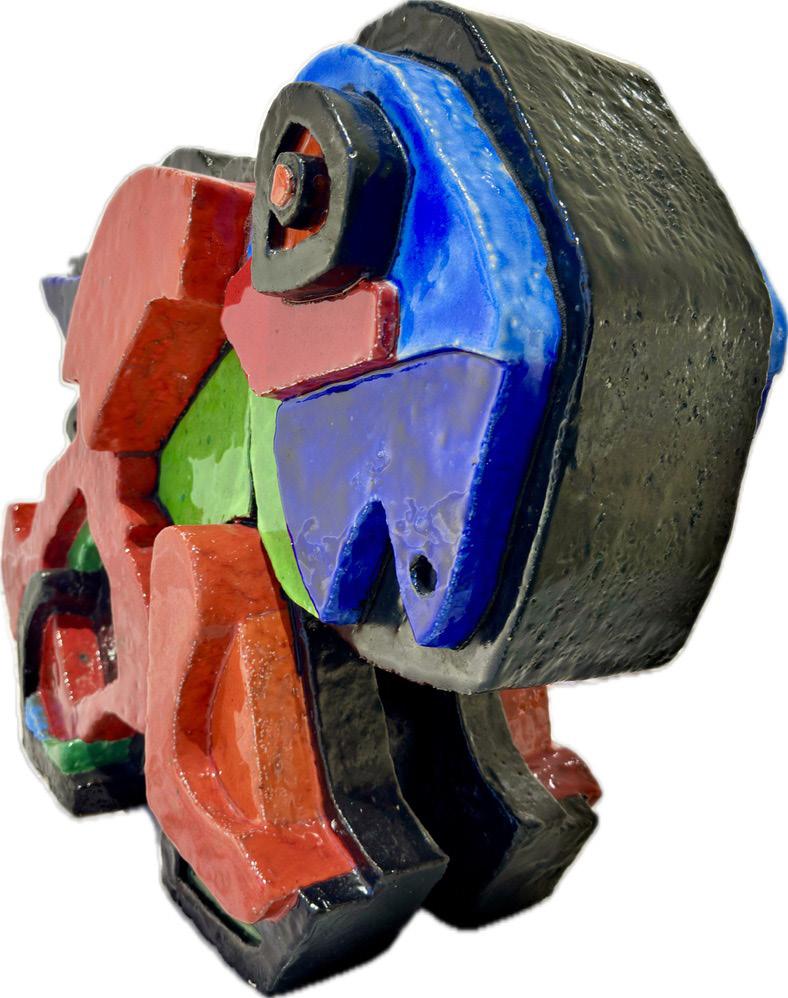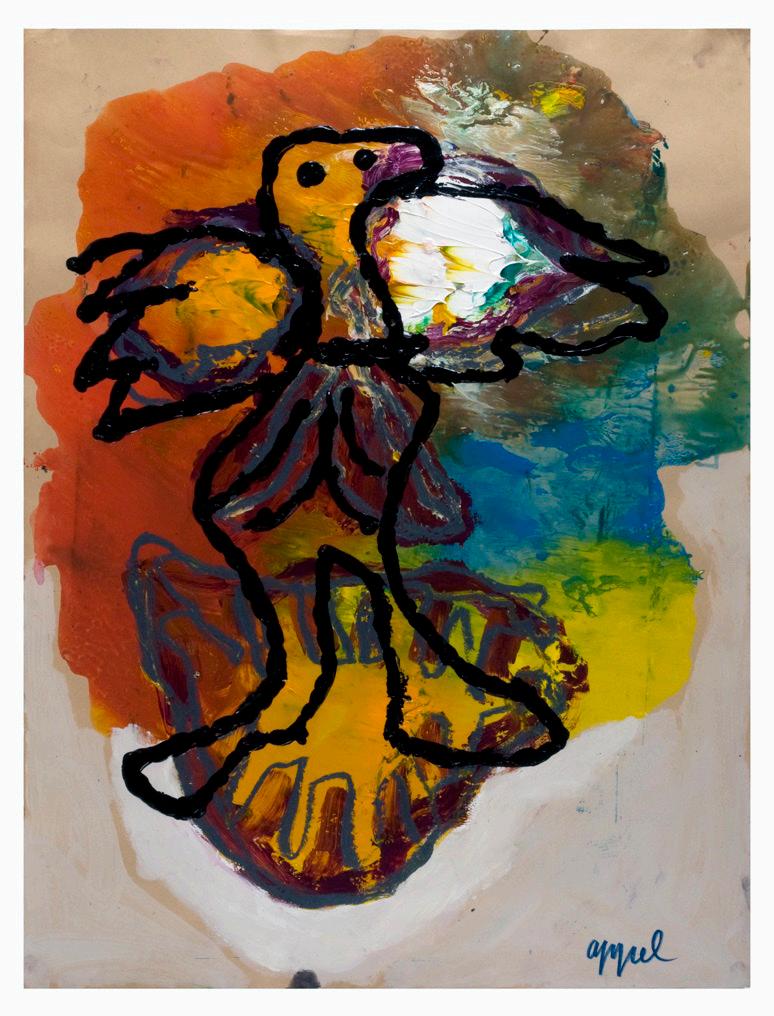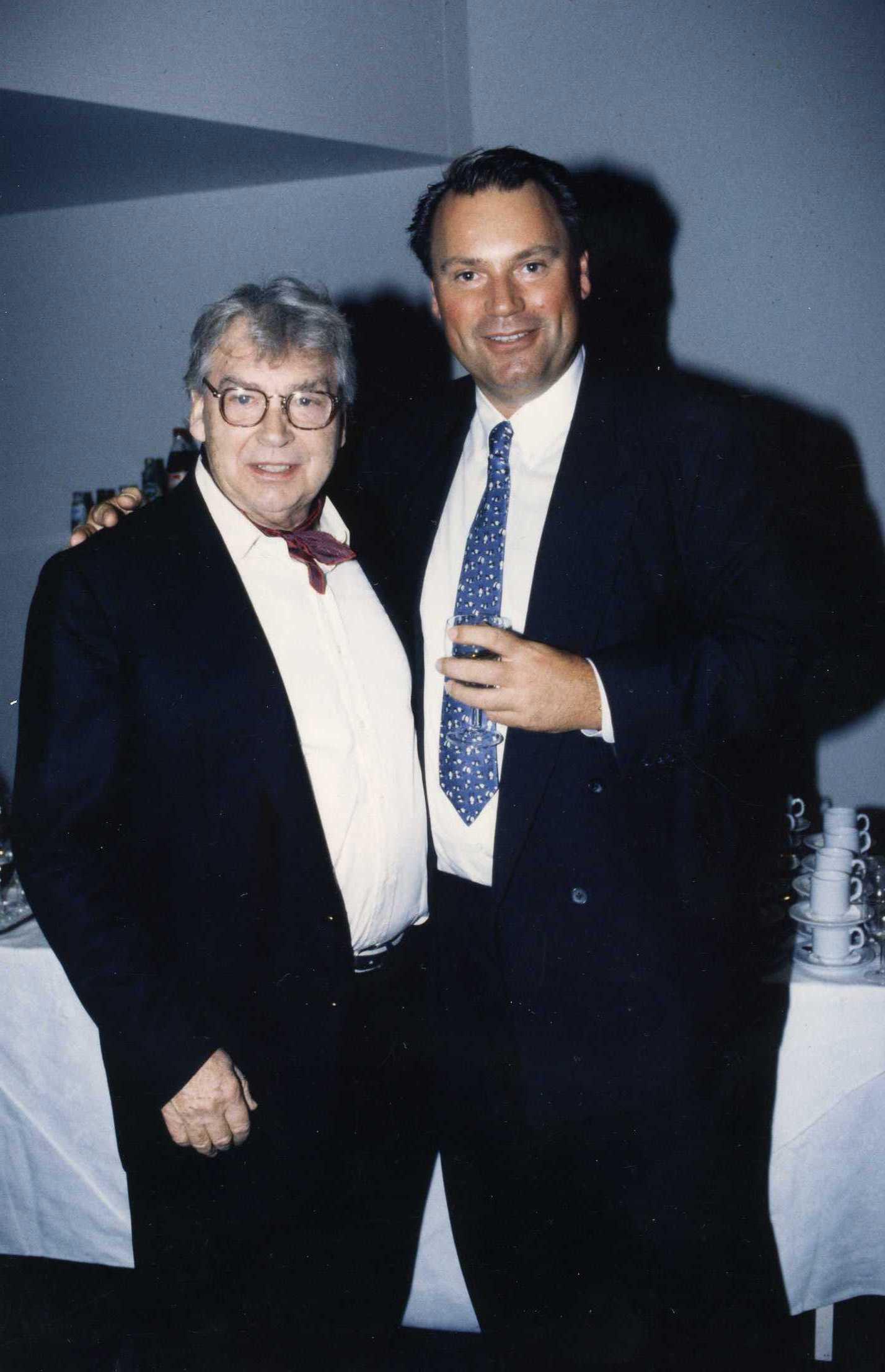

Karel Appel

Karel Appel
Original paintings, drawings and sculptures from 1949-1996
GALLERY DELAIVE
Modern & Contemporary Art

Karel Appel in his Monaco studio, 1991, with the artwork ‘Personages’ on the floor (p.33).
Karel Appel: Art is a Miracle
“Every successful work of art is a miracle” – Karel Appel
When Nico Delaive first met Karel Appel (1921-2006) in the 1980s, the Dutch painter had almost 40 years of art making behind him. With his initial co-founding of the CoBrA movement and subsequent solitary developments in Paris and New York his daring style of intuitive, primal, and abstracted figuration had become world renowned. Despite the initial struggle as an artist the world had become enchanted with his child-like compositions from the 40s and early 50s such as Untitled (p.7), his expressive gestural style of the late 50s and 60s (Bird, p.9; Tête, p.13; Mother and Child, p.15) and the merging of both in the early 1970s (Figura, p.16; The Happy Flower, p.17; and Untitled, p.18).
The greatest appeal of Appel’s work was that it went against the grain of artistic convention and bourgeois expectations. It sought to be something truly free and liberating by establishing a more fitting visual language for the period after the devastation and cruelty of World War II. Appel wanted to create “positive chaos” to oppose “negative chaos, which is that barbarism around us.” This urge for freedom was also found in Appel’s approach to his art practice. He set out to (re-)discover new materials and mediums, rethink and question traditional rules and limitations and continuously reinvent his own work.
When Gallery Delaive opened its first solo-show of Karel Appel in the 90s the artist had arrived at a later stage in his career. He had largely lost the temperamental and physical style of painting he had displayed as a younger man, but he was in no way reaffirming himself in his old ways and remained equally as experimental in that period. Rudi Fuchs has pointed out that many Modern artists worked towards a conclusion in their style which they then perfected in their old age, but that Appel - much like Picasso or Matisse - does not fall in this category and instead had set up studios in Tuscany, Monaco, and Connecticut in which he found new inspirations and walked down uncharted artistic avenues.
In the Italian campagna Appel rediscovered his love for nature and made series of large-scale landscape paintings which were unprecedented in his career (Birth of a Landscape, p.38-41). In Monaco, together with radiating small canvasses like Personages (p.33) and Personage (p.37), he made his Fenêtres inspired by Mediterranean painters like Bonnard and Dufy, who would paint from their windows. He also made assemblage pieces (such as Window, p.34) - often in Connecticut - in the same spirit, which continued his experiments with ready-mades and sculptures from the 1970s including Animal (p.19) and Visage (p.20-21).
Appel’s painting practice, together with his experiments outside of it never fell into repetition and were never pushed to one final direction or conclusion. Instead, Appel employed his commitment to artistic freedom and his relentless pursuit of creative expression to arrive at endlessly innovative ‘miracles’ of art. Works such as Figure (p.31), Le Cavalier Vert (p.27) and Personage in Landscape (p.35) are perfect examples of the compelling quality of his later paintings.
Since the 1980s, Nico Delaive built up extensive familiarity with Karel Appel’s life and practice. With this selection of artworks from 1949 to 1996, Gallery Delaive celebrates its long-standing relationship with this titan of Post-War art.

Karel Appel, Untitled, 1949, pastel on paper, 30 x 42 cm.

Karel Appel and Nico Delaive with the artwork Bird

Karel Appel, Bird, 1957, oil on canvas, 116 x 89 cm.

Karel Appel, Entrain de peindre, 1958, pastel and watercolour on paper, 30.5 x 20.5 cm.

Karel Appel, Untitled, 1963, pastel on paper, 30 x 30 cm.

Karel Appel, Figure Composition, 1964, pastels on paper, 32 x 32 cm.

Karel Appel, Tête, 1964, oil on canvas, 28 x 22 cm.

Connecticut, U.S.A., 1992
Karel Appel in his studio in Darien,

Karel Appel, Woman and Child, 1965, oil on canvas, 230 x 190 cm.

Karel Appel, Figura, 1970, oil on canvas, 46 x 38 cm.

Karel Appel, The Happy Flower, 1971, oil on canvas, 45.7 x 45.7 cm.

Karel Appel, Untitled, 1974, oil on canvas, 75 x 100 cm.


Karel Appel, Animal, 1974, glazed ceramic, 51.5 x 66 x 25 cm.

Karel Appel, Visage, 1978, Painted PVC bottle used as a lamp, 29.5 x 17.3 x 15.8 cm.



Karel Appel in his studio in Mercatale, Tuscany, Italy, 1993


Karel Appel, Untitled , 1980, pastel on linen covered book , 39.4 x 30.5 x 3.2 cm.

Karel Appel, Untitled , 1980, oil pastel on book , 40.6 x 63.2 cm.

Karel Appel with the artwork Le Cavalier Vert

Karel Appel, Le Cavalier Vert, 1982, oil on canvas, 190 x 190 cm.

Karel Appel, A postcard of a distant world, 1987, acrylic on paper, 110 x 77 cm.

Karel Appel, Untitled portrait, 1984, oil on canvas, 58 x 38 cm.

Karel Appel, Figure in Red Landscape, 1990, oil on canvas, 180 x 160 cm.

Karel Appel, Figure, 1991, oil on canvas, 81 x 65 cm.

Karel Appel, Two Heads XI, 1991, oil on canvas, 60 x 70 cm.

Karel Appel, Personages, 1991, oil on canvas, 54 x 65 cm.

Karel Appel, Window, 1991, Assembly piece of wood and various other materials, 230 x 110 x 55 cm.

Karel Appel, Personage in Landscape, 1992, oil on canvas, 122 x 152 cm.

99Karel Appel with Nico Delaive in his studio in Mercatale, Tuscany, Italy, 1993

Karel Appel, Personage, 1992, oil on canvas, 41 x 33 cm.

Karel Appel, Birth of a landscape no. 11, 1996, oil on canvas, 140 x 200 cm.


Karel Appel, Birth of a Landscape no. 25, 1996, oil on canvas, 140 x 200 cm.


Die Zauberflöte, 1996
Karel Appel and Nico Delaive at the opera
Copyright Gallery Delaive, Amsterdam Nico Delaive
Published by Gallery Delaive, Amsterdam
Lay-out Niki Delaive
Text Thomas Dobbelaer
Special thanks Karel Appel Foundation
The included artworks are registered and recognized by the Karel Appel Foundation
Gallery Delaive Spiegelgracht 23 1017 JP Amsterdam The Netherlands
Tel: +31 20 6259087 / +31 6 53222087 info@delaive.com - www.delaive.com
Maart 2024
Colofon

